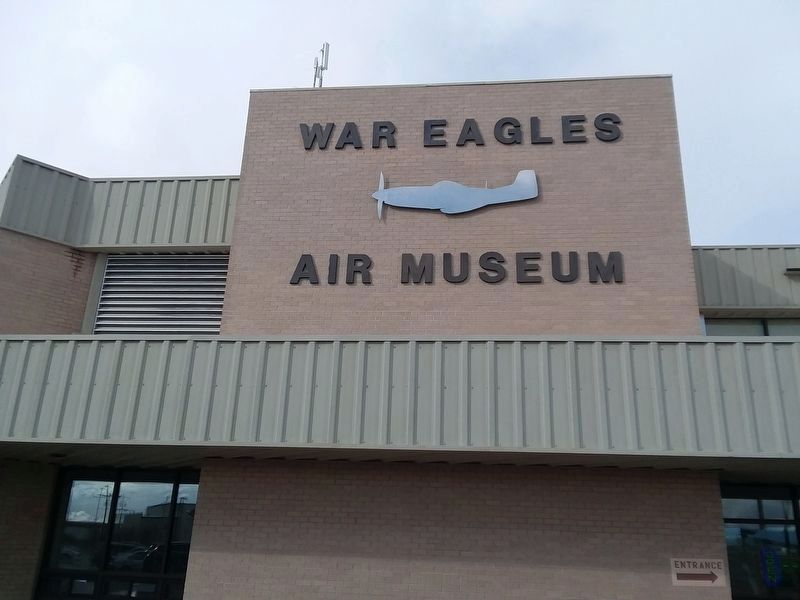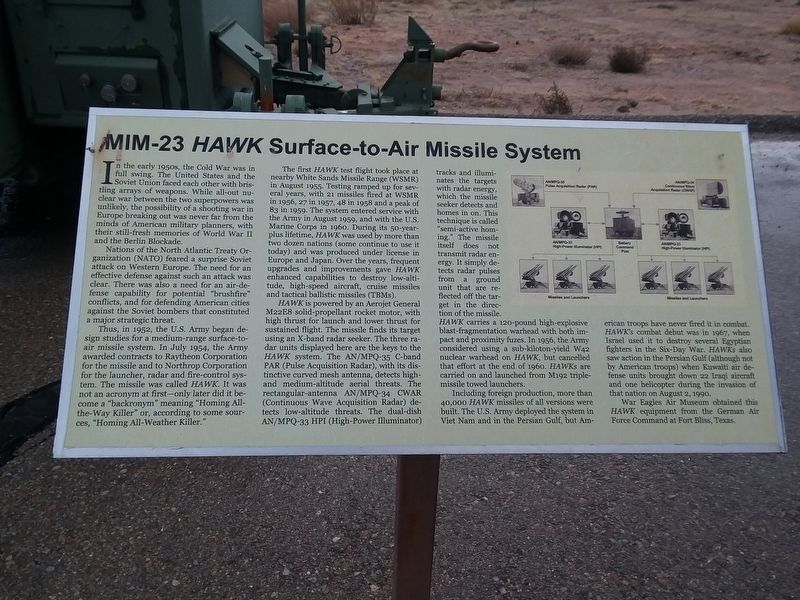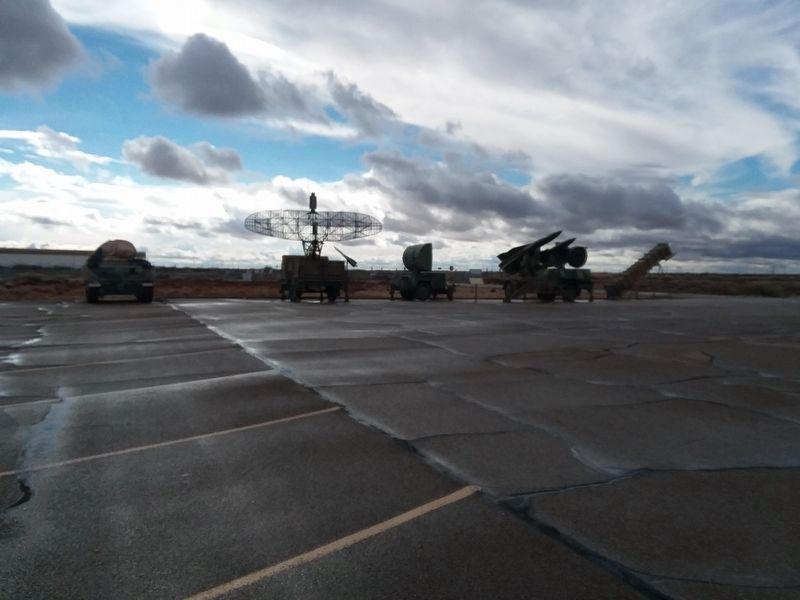Santa Teresa in Dońa Ana County, New Mexico — The American Mountains (Southwest)
MIM-23 Surface-to-Air Missile System
War Eagles Museum
In the early 1950s, the Cold War was in full swing. The United States and the Soviet Union faced each other with bristling arrays of weapons. While all-out nuclear war between the two superpowers was unlikely, the possibility of a shooting war in Europe breaking out was never far from the minds of American military planners, with their still-fresh memories of World War II and the Berlin Blockade.
Nations of the North Atlantic Treaty Organization (NATO) feared a surprise Soviet attack on Western Europe. The need for an effective defense against such an attack was clear. There was also a need for an air-defense capability for potential "brushfire" conflicts, and for defending American cities against the Soviet bombers that constituted a major strategic threat.
Thus, in 1952, the U.S. Army began design studies for a medium-range surface-to-air missile system. In July 1954, the Army awarded contracts to Raytheon Corporation for the missile and to Northrop Corporation for the launcher, radar and fire-control system. The missile was called HAWK. It was not an acronym at first-only later did it become a "backronym” meaning "Homing All-the-Way Killer” or, according to some sources, "Homing All-Weather Killer."
The first HAWK test flight took place at nearby White Sands Missile Range (WSMR) in August 1955. Testing ramped up for several years, with 21 missiles fired at WSMR in 1956, 27 in 1957, 48 in 1958 and a peak of 83 in 1959. The system entered service with the Army in August 1959, and with the U.S. Marine Corps in 1960. During its 50-year-plus lifetime, HAWK was used by more than two dozen nations (some continue to use it today) and was produced under license in Europe and Japan. Over the years, frequent upgrades and improvements gave HAWK enhanced capabilities to destroy low-altitude, high-speed aircraft, cruise missiles and tactical ballistic missiles (TBMS).
HAWK is powered by an Aerojet General M22E8 solid-propellant rocket motor, with high thrust for launch and lower thrust for sustained flight. The missile finds its target using an X-band radar seeker. The three radar units displayed here are the keys to the HAWK system. The AN/MPQ-35 C-band PAR (Pulse Acquisition Radar), with its distinctive curved mesh antenna, detects high-and medium-altitude aerial threats. The rectangular-antenna AN/MPQ-34 CWAR (Continuous Wave Acquisition Radar) detects low-altitude threats. The dual-dish AN/MPQ-33 HPI (High-Power illumination) tracks and illuminates the targets with radar energy, which the missile seeker detects and homes in on. This technique is called "semi-active homing.” The missile itself does not transmit radar energy. It simply detects radar pulses from a ground unit that are reflected off the target in the direction of the missile.
HAWK carries a 120-pound high-explosive blast-fragmentation warhead with both impact and proximity fuzes. In 1956, the Army considered using a sub-kiloton-yield W42 nuclear warhead on HAWK, but cancelled that effort at the end of 1960. HAWKS are carried on and launched from M192 triple-missile towed launchers.
Including foreign production, more than 40,000 HAWK missiles of all versions were built. The U.S. Army deployed the system in Viet Nam and in the Persian Gulf, but American troops have never fired it in combat. HAWK's combat debut was in 1967, when Israel used it to destroy several Egyptian fighters in the Six-Day War. HAWKs also saw action in the Persian Gulf (although not by American troops) when Kuwaiti air defense units brought down 22 Iraqi aircraft and one helicopter during the invasion of that nation on August 2, 1990.
War Eagles Air Museum obtained this HAWK equipment from the German Air Force Command at Fort Bliss, Texas.
Topics. This historical marker is listed in this topic list: Military. A significant historical month for this entry is July 1954.
Location. 31° 52.531′ N, 106° 42.021′ W. Marker is in Santa Teresa, New Mexico, in Dońa Ana County. Marker is on Airport Road, on the right when traveling west. The marker

Photographed By Craig Doda, December 26, 2018
3. War Eagles Air Museum
Museum website homepage
Click for more information.
Click for more information.
Other nearby markers. At least 8 other markers are within 12 miles of this marker, measured as the crow flies. La Salineta (approx. 7.6 miles away in Texas); Texas (approx. 10 miles away in Texas); El Paso (approx. 10 miles away in Texas); Ońate’s Route (approx. 11.4 miles away); Brazito Battlefield (approx. 11.4 miles away); Butterfield Trail/Espejo's Expedition (approx. 11.4 miles away); El Paso Del Rio Del Norte (approx. 11.8 miles away); International Boundary and Water Commission (approx. 11.9 miles away).
Credits. This page was last revised on June 6, 2022. It was originally submitted on December 10, 2020, by Craig Doda of Napoleon, Ohio. This page has been viewed 306 times since then and 51 times this year. Photos: 1, 2, 3. submitted on December 10, 2020, by Craig Doda of Napoleon, Ohio. • J. Makali Bruton was the editor who published this page.

